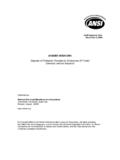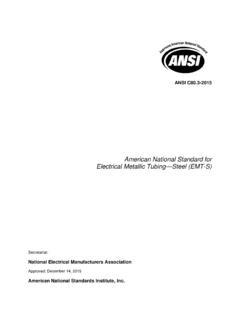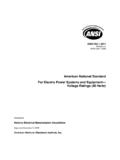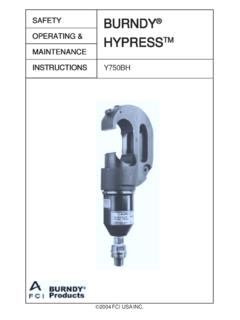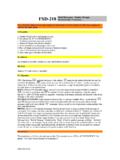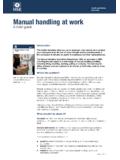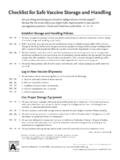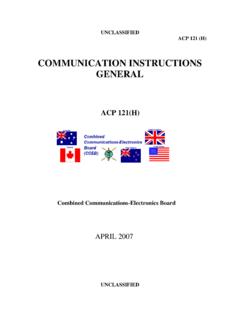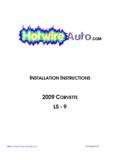Transcription of guidelines for handling water damaged electrical …
1 guidelines FOR handling water - damaged electrical EQUIPMENT NATIONAL electrical MANUFACTURERS ASSOCIATION 1300 NORTH 17TH STREET, SUITE 1752 ROSSLYN, VIRGINIA 22209 703 841-3200 703 841-5900 FAX guidelines for handling water - damaged electrical Equipment NOTICE AND DISCLAIMER Please see the last page of this document. Use of this Publication This publication provides guidelines on how to handle electrical equipment that has been exposed to water through flooding, fire fighting activities, hurricanes, etc. It is designed for use by suppliers, installers, inspectors, and users of electrical products. electrical equipment exposed to water can be extremely dangerous if reenergized without proper reconditioning or replacement. Reductions in integrity of electrical insulation due to moisture, debris lodged in the equipment components, and other factors, can damage electrical equipment by affecting the ability of the equipment to perform its intended function.
2 Damage to electrical equipment can also result from flood waters contaminated with chemicals, sewage, oil, and other debris that will affect the integrity and performance of the equipment. Ocean water and salt spray can be particularly damaging due to the corrosive and conductive nature of the salt water residue. Distributors of electrical equipment should not use any inventory that has been subjected to water damage. damaged inventory should not be sold to resellers that will place the equipment back into the market. This can lead to damaged equipment still being used and creating a hazard to individuals or property. To Contact the Manufacturer Working knowledge of electrical systems and of the equipment in question is required to evaluate damage due to contact with water . The original manufacturer of the equipment should be contacted if any questions arise or specific recommendations are needed. In many cases, replacement will be necessary. After consultation with the manufacturer, some larger types of electrical equipment may be reconditioned by properly trained personnel.
3 The ability to recondition the equipment may vary with the nature of the electrical function, the degree of flooding, the age of the equipment, and the length of time the equipment was exposed to water . Attempts to recondition equipment without consulting the manufacturer can result in additional hazards due to the use of improper cleaning agents, which can further damage the equipment (see National electrical Code Section 110-11 FPN ) or due to improper reconditioning techniques. NEMA member companies are committed to safety. For specific contacts within these manufacturing firms, call or write: National electrical Manufacturers Association 1300 North 17th Street, Suite 1752 Rosslyn, Virginia 22209 Telephone: (703) 841-3236 Fax: (703) 841-3336 ATTN: Vince Baclawski email: electrical Distribution Equipment electrical distribution equipment usually involves switches and low-voltage protective components such as molded case circuit breakers and fuses, within assemblies such as enclosures, panelboards, and switchboards.
4 These assemblies can be connected to electrical distribution systems using various wiring methods. The protective components are critical to the safe operation of distribution circuits. Their ability to protect these circuits is adversely affected by exposure to water and to the minerals and particles which may be present in the water . In molded case circuit breakers and switches, such exposure can affect the overall operation of the mechanism through corrosion, through the presence of foreign particles, and through removal of lubricants. The condition of the contacts can be affected and the dielectric insulation capabilities of internal materials can be reduced. Further, some molded case circuit breakers are equipped with electronic trip units and the functioning of these trip units might be impaired. For fuses, the water may affect the filler material. A damaged filler material will degrade the insulation and interruption capabilities. Distribution assemblies contain protective components together with the necessary support structures, buswork, wiring, electromechanical or electronic relays and meters.
5 Exposure to water can cause corrosion and insulation damage to all of these areas. In the case of exposure of distribution assemblies to water , the manufacturer should be contacted before further action is taken. Items Which May Possibly Be Reconditioned by Trained Personnel in Consultation with Manufacturer: Enclosed switches reference NEMA Standards Publication KS 1-2001, Enclosed and Miscellaneous Distribution Equipment Switches (600 Volts Maximum), para , Busway reference NEMA Standards Publication BU , General Instructions for handling , Installation, Operation, and Maintenance of Busway Rated 600 Volts or Less, para , Panelboards reference Standards Publication ANSI/NEMA PB , General Instructions for Proper Installation, Operation, and Maintenance of Panelboards Rated 600 Volts or Less, para. , , Switchboards reference Standards Publication ANSI/NEMA PB , General Instructions for Proper handling , Installation, Operation and Maintenance of Deadfront Distribution Switchboards Rated 600 Volts or Less, para.
6 , Fire Pump Controllers reference NEMA Standards Publication ICS 15-1999 (R2004), Instructions for the handling , Installation, Operation, and Maintenance of Electric Fire Pump Controllers Rated Not More Than 600 V Motor Circuits Motor circuits include motor control devices such as motor starters and contactors, together with overcurrent protection components such as overload relays, circuit breakers, and fuses often assembled into motor control panels and motor control centers as well as individual enclosures. Motor control centers contain both control and protective components together with support structures, buswork, and wiring. The protective components are critical to the safe operation of motor circuits and their ability to protect these circuits is adversely affected by exposure to water , and to the minerals and particles which may be present in the water . For molded case circuit breakers, such exposure can affect the overall operation of the mechanism through corrosion, through the presence of foreign particles, and through removal of lubricants.
7 The condition of the contacts can be affected and the dielectric insulation capabilities of internal materials can be reduced. Further, some molded case circuit breakers are equipped with electronic trip units, and the functioning of these trip units might be impaired. For fuses, the water may affect the filler material. A damaged filler material will degrade the insulation and interruption capabilities. Corrosion, loss of lubrication, and insulation quality can also be expected in contactors and starters. However, solid-state motor controllers and those electromechanical contactors or starters with integral electronic circuitry will be more severely affected by water . Drives damaged by water can be remanufactured by the original manufacturer in some cases. Contact the drive manufacturer for specifics. Items Requiring Complete Replacement: Electronically controlled and solid state contactors and starters Components containing semiconductors and transistors Overload relays Molded case circuit breakers and molded case switches reference NEMA Standards Publication AB 4-2003, guidelines for Inspection and Preventive Maintenance of Molded Case Circuit Breakers Used in Commercial and Industrial Applications, para Fuses Items Which May Possibly be Reconditioned by Trained Personnel in Consultation with Manufacturer: Manual and magnetic motor controllers Motor control centers Power Equipment Power equipment involves low voltage or medium voltage protective devices within an overall switchgear assembly.
8 The assembly may also contain cabling, buswork with appropriate insulators, current transformers, electromechanical or electronic relays, and metering. Reliable operation of the protective devices is vital to system safety; however, these devices can be adversely affected by water . In the case of low voltage and medium voltage circuit breakers and switches, the operation of the mechanism can be impaired by corrosion, by the presence of particles such as silt, and by the removal of lubricants. The dielectric properties of insulation materials and insulators will degrade and, for air circuit breakers, the condition of the contacts can be affected. Further, low voltage power circuit breakers usually incorporate electronic trip units; the functioning of these units will be impaired. Similarly, the functionality of electronic protective relays and meters can be impaired. In the case of fuses, water may affect the filler material. A damaged filler material will degrade the insulation and interruption capabilities of fuses.
9 Power circuit breakers and medium voltage breakers are designed to be maintainable with the possibility, for example, of replacing contacts in air circuit breakers. It may, therefore, be possible to reuse such breakers provided the refurbishing is performed in close consultation with the manufacturer. This would include cleaning and drying techniques, lubrication advice, and thorough testing prior to the reapplication of power. However, the electronic trip units of low voltage power circuit breakers, and electronic protective relays and meters in any power equipment should be discarded and replaced, or at least returned to the manufacturer for inspection and possible refurbishment. In the case of fused equipment, the fusible units should be replaced, and the remainder of the apparatus may be suitable for refurbishing in close consultation with the manufacturer. In all cases, great attention must be paid to the thorough cleaning, drying, and testing of insulators and insulation material.
10 The power equipment can be expected to contain additional electronic units such as solid state relays. These units can also be vital to the correct functioning of the protective device, and great care is needed in the cleaning and testing of such units. A first recommendation is to return the devices to the manufacturer. If this is not possible, the manufacturer should be consulted, for example, on the correct selection of cleaning agents which remove impurities without damaging the conformal coating. The manufacturer must also be contacted relative to the exact testing required of sophisticated electronic equipment containing, for example, microprocessors. The overall power equipment assembly (switchgear) may be able to be reconditioned provided careful steps are taken in the cleaning, drying, and testing of the equipment prior to applying power. This would require input and advice from the manufacturer. An area of particular concern is the maintenance of the dielectric properties of insulation.
